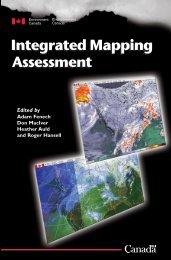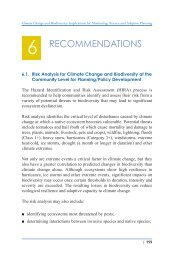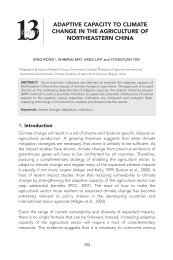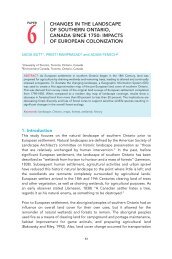Paper 3: Climate Change Adaptation for Neophytes - UPEI Projects
Paper 3: Climate Change Adaptation for Neophytes - UPEI Projects
Paper 3: Climate Change Adaptation for Neophytes - UPEI Projects
Create successful ePaper yourself
Turn your PDF publications into a flip-book with our unique Google optimized e-Paper software.
LINKING CLIMATE MODELS TO POLICY AND DECISION-MAKINGGiven what has already occurred and what may be possible, there is naturallymuch speculation and debate over what should be done. At the most generallevel, there are two basic responses: to mitigate or to adapt. Presumably theguiding rationale <strong>for</strong> the IPCC is to avoid “dangerous anthropogenicinterference with the climate system” (Article 2 of the UNFCCC) which suggestsa mitigation ef<strong>for</strong>t. Accordingly, the Synthesis lists examples of mitigationactions <strong>for</strong> key sectors including the policies, measures and instruments <strong>for</strong>implementing these strategies, and the constraints or barriers that prevent theirimplementation. Furthermore, it attempts to monetarize those options in acomparative framework and offer stabilisation strategies which are accompaniedby timeframes <strong>for</strong> action.<strong>Adaptation</strong> options are also listed and their accompanying policy implications,barriers and constraints, but comparative frameworks appear lacking. It is notedthat adaptation is confounded by numerous factors, including current climatehazards, poverty and unequal access to resources, food insecurity, trends ineconomic globalisation, and conflict and incidence of diseases such as HIV/AIDS.The best adaptation results appear to occur when strategies are associated withother initiatives. A need is identified to discover systems that would allow theintegration of adaptation and mitigation, in the context of sustainabledevelopment, but beyond individual examples it is difficult to ascertain how thiswould be accomplished. Nevertheless, the AR4 paints a clear picture of theneed <strong>for</strong> immediate and simultaneous action on mitigation, and adaptationstrategies.The IPCC review process represents a monumental undertaking which has beensuccessful in accumulating, interpreting and disseminating “greater knowledgeabout man-made climate change” as well as laying the foundations <strong>for</strong>“measures that are needed to counteract such change 7 .” Nevertheless, AR4cannot help but be a single snapshot of an extremely large and evolving field.AR4 gives some direction in terms of where the field may be heading, but isnecessarily outdated even as it is published. It provides a heavily aggregated,implicitly biased perspective, leaving the reader with no sense of what was leftout, or where speculative or innovative research may be found. It should benoted that this is not a flaw of the authors but rather inherent to the reviewprocess itself. This current review is meant to offer the researchers tools toaccess the CCA literature, and a framework(s) upon which to structure theirmental models.7 Quote from the declaration of the accomplishments of the IPCC and Al Gore <strong>for</strong> the Nobel Peace Prizehttp://nobelprize.org/nobel_prizes/peace/laureates/2007.50










